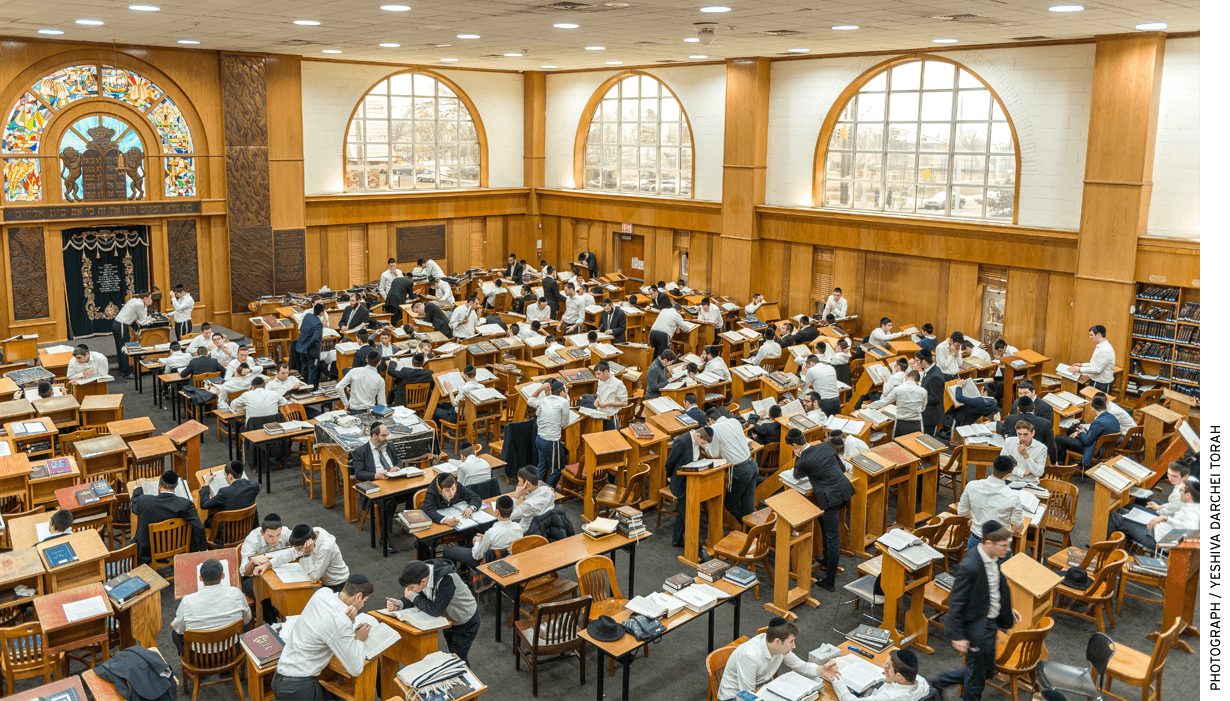
When the New York Times ran an article headlined “Do Children Get a Subpar Education in Yeshivas? New York Says It Will Finally Find Out,” the newspaper illustrated the piece with a photo of a Jewish school in Queens.
An administrator from that school promptly complained to the Times about its photo selection, pointing out that six of the school’s recent graduates had attended Harvard Law School.
So the Times website swapped out the photo, replacing it with one of a Jewish school in Brooklyn. An administrator there complained too—noting that the school offers 24 Advanced Placement courses, including ones in physics, computer science, and calculus.
The Times then took down this second photo, replacing it online with a picture of an advocate whose organization sued the governor of New York in an attempt to force more secular instruction in Jewish private religious schools.
This episode from December 2018 neatly reflects the years-long policy battle over the curricula in Jewish schools in New York and the government’s role in overseeing them. High-quality educational offerings and outcomes are met with accusations of inferiority. And the Times is paying close, if clumsy, attention.
One can understand why. It’s a good story, of interest well beyond the Jewish community. Jewish schools educated more than 151,000 students in New York State in 2013, the last year a careful count was done. That’s more than the number enrolled in the Philadelphia City or San Diego Unified public-school districts. And taxpayers have a stake in how well the yeshivas are doing their jobs. The Jewish schools absorb more than $100 million a year in city government funds for things such as textbooks, special education, security, and transportation. What’s more, if yeshiva students don’t get the skills necessary to participate in the economy, other taxpayers may be stuck supporting them with subsidized housing and medical care, the schools’ critics contend.
Some Jewish schools serve essentially like other private schools, as feeders to secular higher education or the workplace. The critics, though, are focused on the education in ultra-Orthodox schools, especially Hasidic institutions. Hasidim are Orthodox Jews loyal to a particular charismatic rabbi; they live in tight-knit communities, dress in traditional garb, and closely follow the teachings of the Torah and Talmud. Boys spend most of their school day studying these sacred texts and related writings, often to the near exclusion—critics contend—of traditional school subjects such as English and math.
The mayor of New York, its city schools chancellor, the state and federal courts, and even Governor Andrew Cuomo have been drawn into the dispute, which at one point was used by a state senator to hold up negotiations over the Empire State’s entire $168 billion annual budget.
It’s also a story that extends beyond education outcomes and New York politics to deeper philosophical and legal issues: religious liberty, state power, and family freedom. How much authority should the city and state have to impose the government’s vision of an education on a religious minority that would prefer to be left alone? How much power should parents have to send their children to schools that emphasize religious subjects at the expense of topics such as science or math? Does society have a responsibility to ensure that all children receive an education that enables them to participate in democracy and the workplace? And who determines the answers to these questions—parents, politicians, courts, bureaucrats, advocacy groups, or some complicated combination thereof?
The advocate whose photo the Times finally settled upon, Naftuli Moster, was dissatisfied with the education he received at the yeshivas he attended as a child. In a federal civil complaint his advocacy group filed in 2018 against Cuomo and the state commissioner of education, he cited a New York Post headline contending “Jewish schools are dooming young men to poverty.” The complaint—which in January 2019 was dismissed in district court for lack of standing—charged that “although non-public schools are required by state law to provide a substantially equivalent secular education, almost no secular education is provided at most Hasidic ultra-Orthodox Jewish non-public schools. . . . The language of instruction is almost exclusively Yiddish, the same language the students speak at home, and sometimes includes some Hebrew and/or Aramaic texts.”
Then in March 2019, a Jewish advocacy group that supports the religious schools, Parents for Educational and Religious Liberty in Schools, along with five of the schools and some individual parents, filed a lawsuit in state court. That suit challenged guidelines the state of New York announced late last year, which had called for onsite evaluation of all non-public schools every five years. Schools that failed those evaluations risked losing public funding for textbooks and transportation, and parents at failing schools potentially faced liability under truancy laws.
The complaint contends that the guidelines “violate both the United States Constitution and the New York Constitution,” invoking the free exercise of religion, a free-speech right to determine what to teach, and a “constitutionally protected due process right to control the upbringing and education of their children.” On April 18, a state judge overruled the new guidelines on procedural grounds, but the issue remains a live one; the state has said that it “will determine the appropriate next steps.”
The whole fight hinges on language in New York’s state education law requiring that non-public schools offer an education that is “substantially equivalent” to that of the public schools. The origins of that language help uncover the issues at stake.
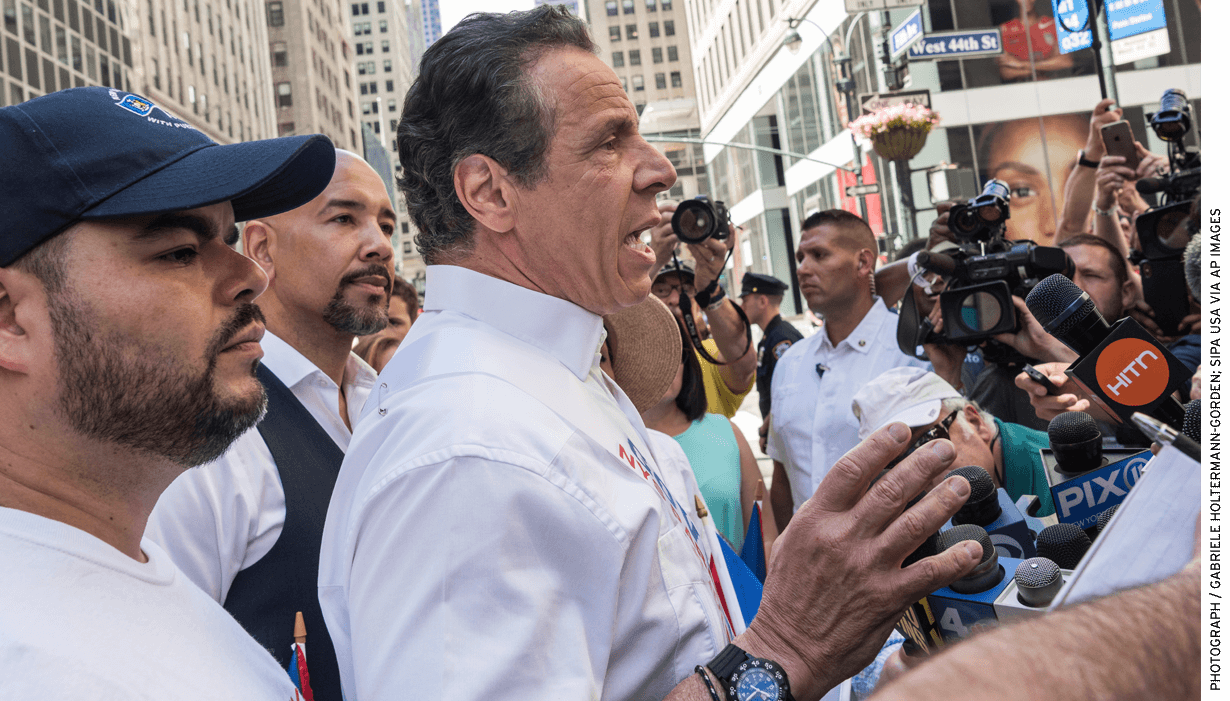
1894
If the current controversy is to some degree an intra-Jewish dispute, it’s being fought against the backdrop of education law that was largely shaped by a conflict between Catholics and Protestants in the second half of the 19th century—a battle over control of tax dollars for education.
Nationally, the key figure in that fight was James G. Blaine. The son of a Presbyterian father and a Catholic mother, Blaine served as a congressman from Maine, Speaker of the House, a U.S. senator, secretary of state, and, in 1884, the Republican Party’s presidential nominee. Today, though, he is best known for championing a constitutional amendment in 1875 stipulating that “no money raised by taxation in any State for the support of public schools, or derived from any public fund therefor, nor any public lands devoted thereto, shall ever be under the control of any religious sect.”
The federal Blaine Amendment failed, but the effort moved to the states, 38 of which adopted some form of it in their own constitutions (see “Answered Prayer?” legal beat). In a 2000 opinion, Mitchell v. Helms, four justices of the U.S. Supreme Court noted what they called the “shameful pedigree” of the Blaine Amendments, adding that the national one was considered “at a time of pervasive hostility to the Catholic Church and to Catholics in general, and it was an open secret that ‘sectarian’ was code for ‘Catholic.’”
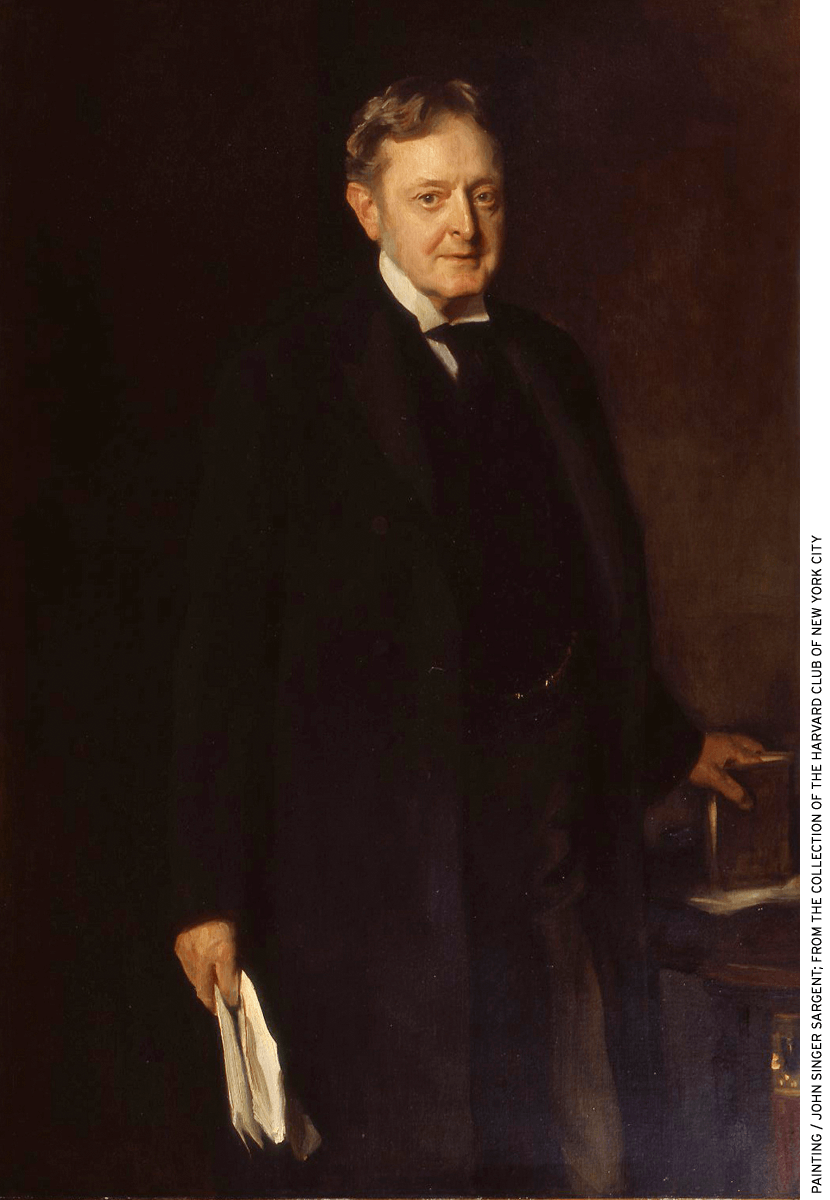
In New York, a key figure in the story of the Empire State’s Blaine Amendment was Joseph Hodges Choate. Choate, a graduate of Harvard College and Harvard Law School, was from Salem, Massachusetts, a member of the same family whose name has survived on the Choate Rosemary Hall School in Connecticut and the Choate Hall & Stewart law firm in Boston. A portrait of him, an oil painting by John Singer Sargent, hangs today in a prominent location at the Harvard Club of New York.
Choate was known for his “lasting distrust of the New York Irish as a political force,” as D. M. Marshman Jr. wrote in a 1975 American Heritage profile of the man. The author put the kindest possible face on this bias, attributing it to Choate’s reaction to racist Irish violence against blacks in the 1863 New York draft riots: “He considered them largely responsible for the hangings and tortures that caused hundreds of black men and women to die violently and was bitter because neither Governor [Horatio] Seymour, elected with Irish votes, nor Archbishop [John] Hughes himself made any real effort to stop them.”
In March 1893, in New York City, Choate delivered an after-dinner speech on St. Patrick’s Day to an Irish American social and charitable group. With many Irish Americans supporting the campaign overseas for Irish sovereignty, Choate—the “embodiment of pure English stock and the Republican Party, that is, of what his audience most opposed,” as Marshman put it—told the group that the best thing for them to do was “with your wives and your children, and your children’s children, with the spoils you have taken from America in your hands, set your faces homeward, land there and strike the blow. . . . Think what it would mean for both countries if all the Irishmen of America . . . should march to the relief of their native land! Then, indeed, would Ireland be for Irishmen and America for Americans!” The remarks didn’t earn laughs, though Choate maintained he jested.
A year later, Choate, speaking at a Republican meeting at Cooper Union on the topic of “Tammany Rule,” declared, “We are tired of being submitted to the despotic control of a handful of foreigners who have no stake in the soil.” Catching himself, he quickly asserted that the Republicans “should be just as tired of it if they were not foreigners.”
In May of that year, Choate, then 62, was elected president of the New York State Constitutional Convention. At the time, the New York Times was on high alert for anti-Catholic bigotry. The newspaper reported on a cartoon that the anti-Catholic American Protective Association had mailed to each convention delegate. The drawing depicted a monstrous snake labeled “Catholic Church,” and the Times called it a “rabid and vicious” attack, comparing its vitriol to the hatred exhibited by the New England witch burners in Choate’s hometown. In the same article, a Protestant minister was quoted as saying: “They [the Catholics] only teach the children in their parochial schools to sing ‘Hail Marys.’ That doesn’t benefit them any. . . . We don’t want such systems in our public schools.”
The delegates gathered in the assembly chamber in Albany were there to tackle not just the pressing matter of defunding Catholic schools, but a range of other hot-button issues of the late 19th century: Canals. Railroads. Indians. Prohibition. Women’s suffrage. All 175 delegates were men, and largely opposed to granting women the right to vote, though they did hear from Susan B. Anthony and Jean Brooks Greenleaf, whose husband was a congressman from Rochester.
The convention’s work continued for months. It concluded with a compromise between the aims of Catholics, who hoped to secure funding for their schools and charities, and those who opposed all such support from tax dollars. The Catholics got funding for their charities but not their schools. The convention’s education committee arrived at the following text: “Neither the state nor any sub-division thereof shall use its property or credit or any public money, or authorize or permit either to be used, directly or indirectly, in aid or maintenance, other than for examination or inspection, of any school or institution of learning wholly
or in part under the control or direction of any religious denomination or in which any denominational tenet or doctrine is taught.” New York’s Blaine Amendment was born.
At the same time, the state also added to its education law the requirement that the non-public schools offer an education that is “substantially equivalent” to that of the public schools. That measure was known as the Pound compulsory education law, after its primary sponsor, Cuthbert Winfred Pound, a Republican lawyer from Lockport, in western New York, and the second cousin, once removed, of Roscoe Pound, who would become dean of Harvard Law School. In reporting the legislation’s passage, the New York Tribune wrote that “the measure has been defeated in former years, owing to the fears of Roman Catholics that a compulsory education law would interfere with their parochial schools.” Between the state Blaine Amendment and the Pound law, the overall mood for religious education was embattled, and defensive. Trying to reshape the narrative, the same week that the Pound law was enacted, New York’s Archbishop Michael Augustine Corrigan invited an audience of 2,000 to the opening of a display of parochial-school student art at the Grand Central Palace, a Manhattan exhibition hall. Under the page-one headline “Catholics Are Patriots,” the New York Sun reported the event by noting that William Bourke Cockran, an Irish-born Democratic congressman, “said that he was amazed that at this part of the nineteenth century it was found necessary to repel the charge that the Catholic Church was hostile to republican institutions.”
In mid-October of the same year—1894—a Jewish French army captain, Alfred Dreyfus, was accused of treason. By December 22, he had been convicted with a life sentence. What became known as the Dreyfus affair was covered by a Viennese journalist, Theodor Herzl, who later credited it with inspiring him to become the founder of modern political Zionism. Although the false charges against Dreyfus were ultimately dropped, the affair, and other manifestations of anti-Semitism in Europe in subsequent years, spurred a wave of Jewish immigration to the United States. New York City was the primary arrival point for these immigrants, many of them religiously Orthodox, who soon began to develop religious schools, synagogues, and other community institutions.
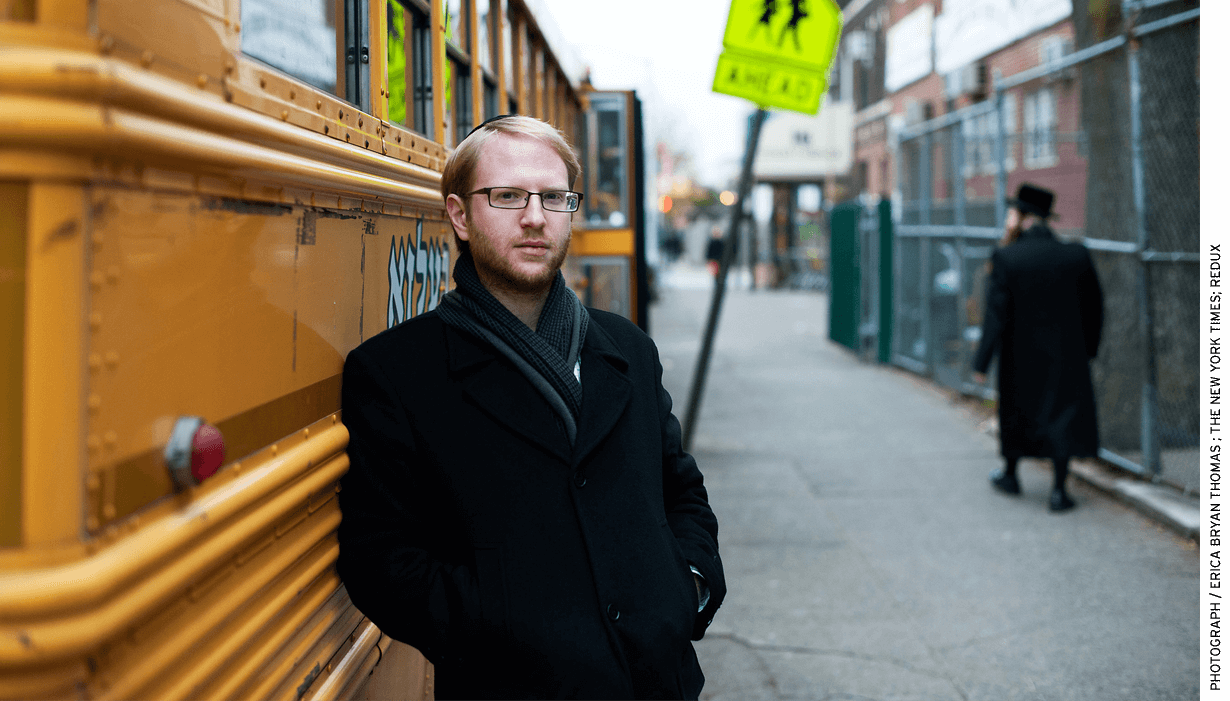
Regulatory Wrangling
From 1894 to 2012, the Jewish schools flourished under a relatively non-intrusive New York regulatory regime. The schools, at times allied with Catholic ones, pressed with limited success for additional funding and even at times for repeal of the Blaine Amendment. In 1973, the U.S. Supreme Court struck down a New York State program designed to fund school building repairs and reimburse parents for religious school tuition, ruling in Committee for Public Education & Religious Liberty v. Nyquist that the program violated the First Amendment’s establishment clause.
Some of the bitterest legal flare-ups involved not Jewish private schools but public-school districts, including that of Kiryas Joel, a Hasidic village about 50 miles northwest of Manhattan. In 1994, the U.S. Supreme Court struck down as unconstitutional the state’s creation of a school district whose boundaries corresponded with those of the village. But the “substantially equivalent” language wasn’t much tested.
In 2001, the state established guidelines suggesting that local education officials make site inspections of non-public schools to investigate compliance only after “a serious concern arises,” and then only after having an informal discussion with the school officials.
The legislative language from 1894, though, was key to the complaint issued by Naftuli Moster in 2015. Moster grew up in Brooklyn as one of 17 children in a family of Hasidic Jews of the Belz sect, which is named after the town in Ukraine where the rabbinic dynasty that leads the group was founded in the 19th century. Moster attended New York Hasidic schools until age 16, when he went to Israel to study. He told the Rockland/Westchester Journal News that from about the time he turned 13, he received no secular education at all. He couldn’t do long division or write an essay; he didn’t know what a molecule or cell was; and he hadn’t heard of the American Revolution, he told the New York Jewish Week.
In July 2015, Moster’s group, Young Advocates for Fair Education, wrote to seven New York school superintendents alleging that yeshivas in their educational districts offered “poor quality and scant amount of secular education, particularly English instruction.” The writers identified themselves as parents, students, and teachers at the schools who were “seriously concerned that these yeshivas are not providing an education that meets the requirement of substantial equivalence.” For the most part, they alleged, yeshiva students may expect to learn a combined 90 minutes of English and math four times weekly, and other secular studies are ignored. This all stops at age 13 for boys, and although Hasidic girls receive more secular instruction than the boys do, the letter’s authors said they were also concerned about whether Hasidic schools sufficiently prepare girls for their futures.
The group’s complaint called for the investigation of 38 schools in Brooklyn and one in Queens. A state probe ensued, and then in early August, Mayor Bill de Blasio launched a city investigation of the schools. His spokesperson told the Jewish Week that “there is zero tolerance for the kind of educational failure alleged.”
By March 2018, after city investigators had visited more than a dozen of the Jewish schools, state senator Simcha Felder held up the state budget until his colleagues agreed to amend the state law by further specifying what the state would consider in determining “substantial equivalence.” Felder, an Orthodox Jew who represents Brooklyn’s heavily Orthodox neighborhood of Borough Park, is a Democrat who often votes with Republicans and thus wields an influential swing vote in the narrowly divided senate.
Felder’s amendment set out two standards for nonprofit schools with bilingual programs: for elementary and middle schools, the state would consider whether
the curriculum provides academically rigorous instruction that develops critical thinking skills in the school’s students, . . . including instruction in English that will prepare pupils to read fiction and nonfiction text for information and to use that information to construct written essays that state a point of view or support an argument; instruction in mathematics that will prepare pupils to solve real world problems using both number sense and fluency with mathematical functions and operations; instruction in history by being able to interpret and analyze primary text to identify and explore important events in history, to construct written arguments using the supporting information they get from primary source material, demonstrate an understating of the role of geography and economics in the actions of world civilizations, and an understanding of civics and the responsibilities of citizens in world communities; and instruction in science by learning how to gather, analyze and interpret observable data to make informed decisions and solve problems mathematically, using deductive and inductive reasoning to support a hypothesis,
and how to differentiate between correlational and causal relationships.
And for high schools, the amendment said, state officials were to consider whether “the curriculum provides academically rigorous instruction that develops critical thinking skills in the school’s students, the outcomes of which, taking into account the entirety of the curriculum, result in a sound basic education.”
Felder’s amendment was seen as a defense of the Jewish schools. “Parents should have the ability to decide what sort of education their children receive,” he told the New York Times in April 2018. But his success soon appeared to be a Pyrrhic victory.
In November 2018, state education commissioner MaryEllen Elia released guidelines for more extensive general-studies offerings at private schools. The guidelines, which included consequences for noncompliance, called on yeshivas to teach seven subjects to students in grades 1 to 4 and 11 subjects to 5th- to 8th-graders.
“Adding up all of the subjects and time requirements, a yeshiva will have to devote more than six hours every day, five days a week to secular studies,” reported the Yeshiva World. The guidelines also called for the state to inspect the schools and warned that parents would face possible prosecution under truancy laws if they didn’t withdraw their children from schools found to be failing. Those truancy laws call for fines and jail terms for parents found in violation; they could also trigger “educational neglect” charges that could culminate in children being taken away from their parents and placed in foster care, a group home, or a court-ordered guardianship.
That same month, Rabbi Aaron Teitelbaum, the leader of the Kiryas Joel community of Satmar Hasidim, publicly denounced Elia, saying that she had “conspired with traitors and the wicked to persecute” a Jewish community “which only wants to educate its children in accordance to Torah and tradition as has been from generation to generation.”
Teitelbaum, speaking days before the onset of Hanukkah, compared Elia to the villains of the Maccabees’ era in the second century BCE, accusing her of wanting to “remove us from our religion exactly as the Greeks wanted in their time, to destroy the education institutions, a decree of extermination.”
Said Teitelbaum, “in a democratic country there is freedom of religion and they have no right to interfere.” He added, in remarks reported by the Yeshiva World, that if Elia wanted to improve education in the state she should focus on the public schools.
In February 2019, shortly before filing suit, Parents for Educational and Religious Liberty in Schools noted that the New York City education department was advertising two job positions devoted to enforcing the substantial-equivalency law: an executive director and a senior operations director. The duties of the operations position, with a salary of $125,256 and up, included determining whether 250,000 students at 800 religious or independent city schools receive a substantially equivalent education and managing a team for school visits, monitoring curricula, and reconnaissance work. The executive post calls for someone with a “solid understanding” of state educational standards and practices but mentions nothing about fluency in the diverse values, culture, and languages of the schools.
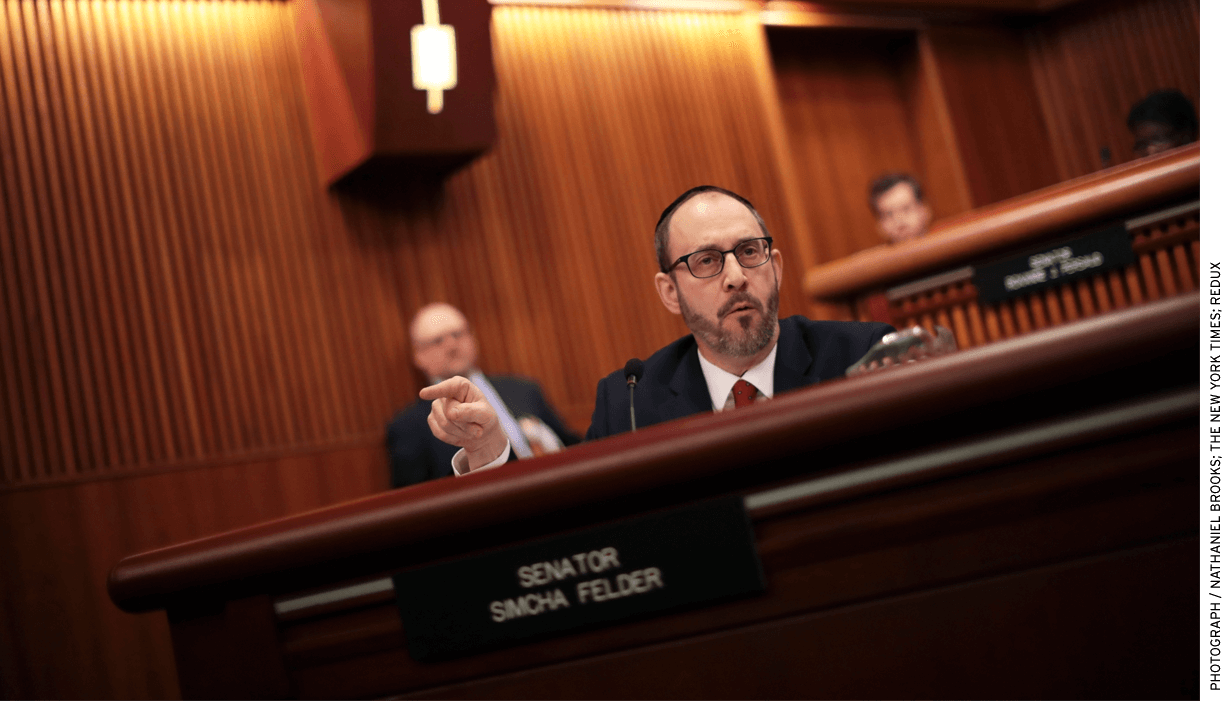
Contrasting Views
With the state’s new guidelines now on hold, it remains to be seen whether those positions will ever be filled. If they are, and the new hires walk through the doors of the yeshivas, what will they see?
The answer can depend on whom you ask.
Rabbi Ysoscher Katz, chair of the Talmud department at the Modern Orthodox (sometimes called “Open Orthodox”) rabbinical school Yeshivat Chovevei Torah, grew up in the Satmar Hasidic sect but now identifies as Modern Orthodox. He called the secular studies of his childhood “literally abysmal,” and said his impression was that teachers were concerned that such training would expose students to the secular world, which they saw as morally corrupt.
A significant number of those classmates graduated unable to write a sound English sentence and without knowing the words “medieval” and “Renaissance,” let alone the difference between the two, Katz said. “I knew nothing about science,” he added.
Inspectors today, Katz said, would likely find that the secular education offered by the Hasidic schools has deteriorated even from the level he and his classmates experienced. In recent years, Hasidic schools have replaced non-Orthodox teachers and the occasional non-Jewish one with Hasidic instructors, Katz said, contending that these non-credentialed, untrained Hasidic teachers leave today’s students even less prepared for work and higher education than their parents and grandparents were.
A contrasting view comes from Moshe Krakowski, an associate professor at Yeshiva University and director of the Jewish education master’s program at its Azrieli Graduate School of Jewish Education and Administration. Krakowski’s research has taken him on visits to schools of several different Hasidic varieties.
“One of the biggest misconceptions is that [students] don’t get any secular education. That’s not true,” Krakowski said. “There isn’t a single Hasidic school that doesn’t offer secular education at least through 8th or 9th grade. We’re not talking about zero secular education for anybody.” After this article was published online, Krakowski contacted Education Next to clarify that there is one school that does not offer formal instruction in English writing, grammar, or spelling but said that it was an outlier.
Not only are schools offering secular studies, Krakowski said, but the training is more than sufficient for students’ needs. The secret kosher sauce, he said, is study of the Talmud, the Hebrew and Aramaic writings on the Jewish Bible codified between the second and sixth centuries. Rabbis teaching Talmud don’t quite ask the same sorts of questions that university professors do, but they often cold-call upon their young students to probe sophisticated questions about ancient and medieval texts. And like law professors, they frequently ask follow-up questions that require students to articulate arguments in a way that demonstrates their grasp of essential points.
“These are things that, honestly, college kids and even graduate students have trouble with,” Krakowski said. “They can’t really do the sorts of things that these kids can do pretty well.” (With a doctorate from Northwestern University and a bachelor’s degree from the University of Chicago, Krakowski is familiar with some of the nation’s most elite schools.)
Krakowski said that, ironically, the state pressure may be counterproductive, because it came at a time when, in his estimation, some Hasidic communities were organically nudging schools in a direction of offering more-substantial secular studies. “When you start pushing from the outside and imposing regulations from the outside, then it becomes treyf,” non-kosher, he said. Even people in the community who want more secular education “are not going to pursue it, because it’s associated now with the ex-Hasidim and the government and the evil outside people who are pushing against us. Ironically, you end up harming the development of a more-robust secular education by doing that.”
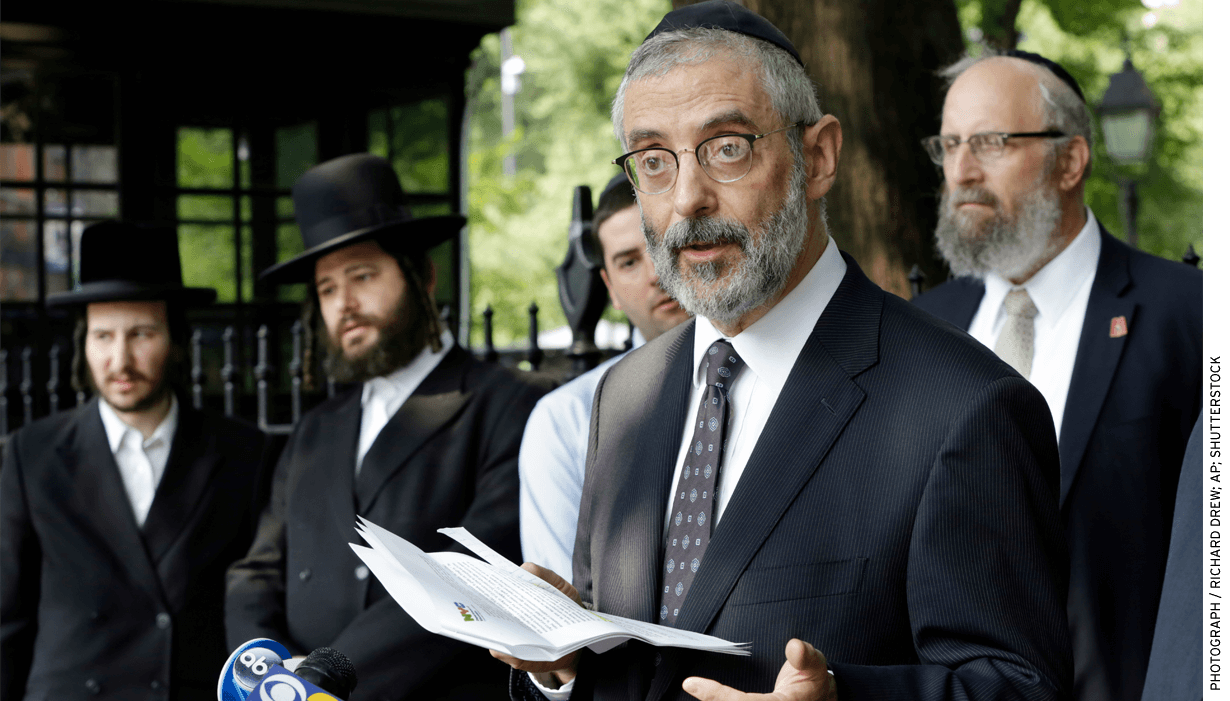
A Look at Two Schools
One day earlier this year, I spent nearly three and a half hours touring about a dozen classes—grades 3 to 7—and talking to administrators, students, teachers, parents, and alumni at two Hasidic schools in Brooklyn. One of them was on the list of 39 schools that Young Advocates for Fair Education flagged as failing. Both asked not to be named in this article.
In one of the schools, the students stood respectfully when my guide—an Orthodox but non-Hasidic rabbi and chair of the secular studies program, who holds a graduate degree from Yeshiva University—entered the room. In a 7th-grade class, an infectiously enthusiastic teacher saw 25 hands shoot up when he sought two volunteers. Two lucky kids came to the front of the room, where the teacher had hung a world map. He acknowledged that the map, which he’d reclaimed from a public-school discard pile, still included the Soviet Union.
“It still works,” he quipped.
The teacher quizzed the boys in an apparently impromptu competition, asking them to locate Sri Lanka; a place where the United States lost a war; the most populous nation in the world; and the Horn of Africa. The duo handled each task with ease—faster than I probably could have. One student erred when the teacher asked the class to name a major Sri Lankan export, but another had a correct response: tea.
“When I see a class like this, and the kids are engaged, and I read an article to the contrary, it breaks my heart,” the secular studies coordinator said to me as we left the room.
In most ways, the classrooms and facilities I saw were no different from any of thousands of others one might visit across the nation. The halls had water fountains, and backpacks, school supplies, and colorful signage abounded. The only details that seemed to set these schools apart were the students’ (and many teachers’) skullcaps, side curls, and ritual fringes. When Gerry Albarelli, a non-Jew, was considering a job offer from the Brooklyn Hasidic school where he would teach for five years, he was warned by the hiring principal to think of it as going to Mars. “These boys live in a very insular world. Not one of them has a television set,” he was told, as he later recorded in his book Teacha! Stories from a Yeshiva. “They speak Yiddish at home; some don’t speak any English at all. We’re up against the impossible.” Albarelli did face challenges, but he also made a lot of progress teaching the boys.
An alumnus of one of the schools I visited, a lawyer, told me that studying for the bar was easier for someone used to spending long days poring over books. And when fellow law students became frustrated trying to tease meaning out of impossibly complicated tax-law codes, he was reminded of studying certain Talmudic volumes that address laws akin to torts.
Rabbi Chaim Dovid Zwiebel, executive vice president of Agudath Israel of America, a nearly century-old advocacy organization for U.S. Orthodox Jewry, also said that his Talmud instruction growing up helped him in law school. “I would not say that about trigonometry or the history of the Ming dynasty, which I learned in high school and never used,” he said.
At both yeshivas, I observed and heard nothing in my interviews suggesting anything but two communities striving to instruct young people as best they knew how, within the context of the religious values they hold dear. “We’re not in the business of wasting people’s time, and whether that is Judaic studies or secular studies, we absolutely believe that it needs to be done well,” a principal told me. “It’s not like secular studies is a secondhand activity that happens at the end of the day, like some kind of afterschool program.” Yet that is exactly what critics allege.
Any school could stage a two-hour charade for a journalist’s benefit, and it’s certainly not uncommon for schools and colleges to closely guide a reporter’s visit. But my impression was that what I heard and witnessed at these two schools was genuine. At one of the Hasidic schools, I was able to talk to any students I chose, and at the other, I didn’t speak directly with students but talked with parents and alumni without restriction.
I talked to 3rd graders writing essays in English about the upcoming Jewish holiday of Purim, and I found their writing to be clear and largely error-free. Students I selected at random happily answered my questions, and when I feigned ignorance about the holiday’s story, they explained to me what they were writing about.
In a teachers’ lounge, an administrator talked me through an elaborate, color-coded computer program, which the school uses to track students’ progress in every subject on a highly granular level.
I spoke at length with a mother, Sarah, whose son is a 3rd grader at the Hasidic yeshiva from which his father graduated. “My son is an active, cute, rambunctious thing. The fact that his teachers can keep this guy engaged somehow until 5 p.m. is a miracle,” she said. Her son is reading Andrew Clements’s children’s novels, which at a public school would be on his grade level. Sarah said she didn’t teach him to read in English. “He’s able to read it and repeat the story back to me and describe the plot and the characters in detail,” she said.
The secular studies coordinator told me that in his first years on the job, boys would demand to know why they needed to learn certain general-studies information. “There’s always a good answer, because if I can’t answer it, it shouldn’t be taught,” he said. Then a group of mothers asked for a meeting to discuss curriculum. They demanded to know: “What are you doing to ensure that my child has a better chance at supporting his family than my husband does?” The coordinator explained what he was trying to accomplish with the secular studies curriculum, noting that preparing the boys for jobs was to be his focus.
These sorts of questions from parents, said Sarah, come amid a shifting tide in the Hasidic world, where many parents increasingly want their children to have better general-studies skills than they have themselves. Yet clearly, many families still value the faith-based education offered at Jewish schools, even though, like most private education, it can be expensive. Tuition at the schools is generally $16,000 nationwide, but can exceed $35,000 at some New York yeshivas, according to the Avi Chai Foundation, which has done research on financing Jewish education; New York City’s annual per-pupil spending in public schools was $25,199 in 2017, according to the U.S. Census Bureau.
Fundamental Questions
What has changed since 1894? Perhaps not some of the religious instruction in the Jewish schools, and certainly not the Jewish texts being studied, some of which date back hundreds, even thousands of years. What is different, though, is who makes the laws of New York State. Whereas in 1894 it was Protestants like Choate and Pound who wielded power, today the state has a Catholic governor, Andrew Cuomo, and its legislature includes the influential Orthodox senator, Simcha Felder.
But if Jewish and Catholic politicians have gained power in the past 125 years, the hold that traditional religion has on Americans, as measured by regular attendance at religious services, has eroded recently. In 2015, the Pew Research Center noted that 36 percent of Americans report weekly religious service attendance, down three percentage points from 2007; between 2007 and 2014, the percentage of U.S. adults who never or rarely attend religious services rose to 30 percent from 27 percent.
Given this decline in religious observance, some see the New York probe of yeshivas in the context of broader infringements by secular or liberal society on traditional religious institutions. In that analysis, the current regulatory effort to evaluate the educational offerings of Hasidic schools seems like just the latest development in a long government push against minority religious education. In 1894, authorities took away funding. In 2019, they’re sending inspectors into schools to check up on them.
Zwiebel, of the Orthodox Agudah, sees the current criticism of Hasidim in the context of a recent surge in anti-Semitism reported by the Anti-Defamation League. Referring to Hasidim as “insular” implies suspicion about what takes place behind closed doors, he said. “There’s a general perception out there that somehow children who grow up in this community are being kept in the dark and the Dark Ages to control them,” Zwiebel said of the Hasidim.
It’s possible that the current conflict could trigger further revision of New York education law, or perhaps even repeal of New York’s Blaine Amendment. A showdown over the state amendments could happen soon in the U.S. Supreme Court, as the court has agreed to hear a Montana case centered on their constitutionality.
As for substantial equivalence, the limits of state authority over private schools have yet to be fully tested. Most likely, that battle will play out in the courts. In Wisconsin v. Yoder, the Supreme Court ruled in 1972 that Amish families had a First Amendment right to end their children’s formal education at the 8th grade, but the ruling was somewhat narrowly tailored.
Zwiebel said the fracas over New York’s Jewish schools should lead the educational establishment to reexamine some fundamental questions, like the purpose of education.
“I hope the commissioner of education is asking herself that today,” he said. Education shouldn’t be about what law books have said it should be for a century, or substantial equivalence, he said. “It’s a dumb way to do it.” Instead, educational institutions should strive to create lifelong learners. That’s something many of the yeshivas do quite well, Zwiebel noted, and of which they are very proud. Whatever their graduates’ English-language skills are, many continue to pore over religious texts daily, long after they’ve graduated from yeshiva.
It’s enough to raise the question: If the state does revisit its education laws, maybe it should consider reversing them—requiring the public schools to be substantially equivalent to the religious ones rather than the other way around.
Menachem Wecker is a freelance journalist based in Washington, D.C. He wrote for the Spring 2019 issue of Education Next about Turkey’s fight against a network of U.S. charter schools.
This article appeared in the Fall 2019 issue of Education Next. Suggested citation format:
Wecker, M. (2019). New York State Cracks Down on Jewish Schools: Senator Simcha Felder and Rabbi Chaim Dovid Zwiebel Meet the Long Shadow of Joseph Hodges Choate. Education Next, 19(4), 28-38.


